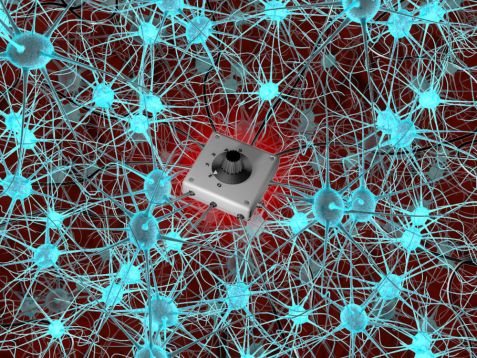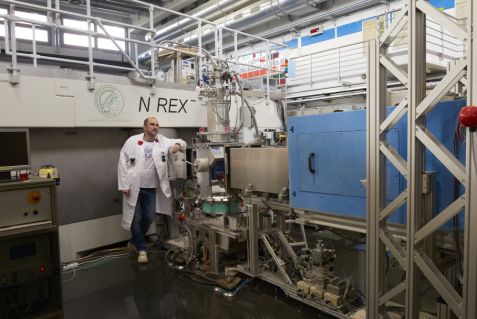MLZ is a cooperation between:
 > Technische Universität München
> Technische Universität München > Helmholtz-Zentrum Hereon
> Helmholtz-Zentrum Hereon
 > Forschungszentrum Jülich
> Forschungszentrum Jülich
MLZ is a member of:
 > LENS
> LENS > ERF-AISBL
> ERF-AISBL
MLZ on social media:

MLZ (eng)
Lichtenbergstr.1
85748 Garching
20.10.2022
Patent for a versatile valve

One possible application for continuous spin valves could be artificial neurons. Interconnected in a larger network, the individual spin valves would output a signal just like real neurons if a certain threshold value of incoming signals is exceeded. The threshold value would be adjustable via the resistance. © Reiner Müller
They are so indispensable that we sometimes forget their role in our everyday lives: Valves were drivers of the industrial revolution. Their electronic cousins, the transistors, kick-started the digital age by enabling logical circuits on ever-smaller components. A new patent, developed at the MLZ and the Max Planck Institute for Solid State Research, makes for the first time so-called spin valves possible, which produce any resistance and could be used as artificial neurons, for example.
In contrast to transistors, where an applied voltage switches a large electrical resistance on and off, the resistance in spin valves is controlled by a magnetic field or, more precisely, its direction. So far, only collinear valves could be realised.
So far only two settings
Just like transistors, these can only switch between two values for the resistance. To do this, two ferromagnetic layers are decoupled from each other by a thin conductor so that both can be magnetised independently of each other. Magnetization involves exposing a ferromagnet to a magnetic field so that the spins inside it align and it maintains its own magnetic field. With relatively weak external fields, this self-produced magnetic field always points along the so-called “easy axis”, which is determined by the material. Both directions along this axis are possible, depending on the direction of the external magnetic field. The trick with binary spin valves is to fix the magnetization of one of the two ferromagnets so that an external magnetic field can only change that of the other. This way, the ferromagnets have the magnetization either in the same direction, which minimises the resistance, or in the opposite direction, which leads to maximum resistance.

Dr Yuri Khaydukov at the NREX instrument. While studying interfaces between superconductors and ferromagnets, he observed that the orientation of the magnetization is fixed when using certain materials. That's when he had the idea of exploiting this effect in continuous spin valves. © Wenzel Schürmann, TUM
Invention makes arbitrary resistances possible
Could one also realize a continuous spin valve in which the two magnetizations can be arbitrarily rotated against each other and thus also produce resistances between the two extreme values? Dr. Yuri Khaydukov, until recently instrument scientist at the NREX of the MLZ, together with colleagues from the Max Planck Institute for Solid State Research and Gitsu Institute of Electronic Engineering and Nanotechnologies, has submitted a patent describing how such a valve could work. The basic mode of operation is similar to that of the binary spin valve. But he turns the tables by varying the direction of the fixed ferromagnetic layer through a clever choice of the used materials for the valve, without affecting the easy axis of the other ferromagnet. This means that all settings between the two extremes of the collinear spin valves are now possible. Yuri Khaydukov came across this effect while investigating the interfaces between ferromagnets and superconductors with neutrons. He noticed in his measurements that the axis of magnetization seemed unexpectedly fixed. He quickly recognized the potential of this discovery and endeavoured to implement it in spin valves.
Candidates for artificial neurons
“The biggest problem so far has been to build non-collinear spin valves in a way that reliably reproduces any setting of the magnetizations and thus also the resistances,” Yuri Khaydukov explains the relevance of his patent. “But that is the most important thing in order to really be able to use them. With this method, it is now possible for the first time and makes the valves versatile,” he continues. The first application that comes to his mind is the realization of artificial neural networks, where a series of input signals are linked together over several layers. The nodes at which input signals converge are the artificial neurons. Just like their biological counterparts, they give an output signal when the sum of the incoming signals exceeds a certain threshold. The neural network learns by constantly adjusting this threshold until it finds the optimum. This is exactly where the continuous spin valves can be used, by having the finely adjustable resistor act as an artificial neuron. Yuri Kaydukov and his colleagues have now applied for a patent for this invention.
Further information:
Description of the patent on the homepage of the Max Planck Society: https://www.max-planck-innovation.com/technology-offers/technology-offer/non-collinear-spin-valve-2.html
Max Planck Innovation: https://www.max-planck-innovation.com/
NREX Instrument: https://mlz-garching.de/nrex
Max Plank Institute for Solid State Research: https://www.fkf.mpg.de/en
Gitsu Institute of Electronic Engineering and Nanotechnologies: https://nanotech.md/e
Related News
-
01.06.2022
On the trail of hydrogen
-
30.09.2021
Triple switch for the nanoworld
MLZ is a cooperation between:
 > Technische Universität München
> Technische Universität München > Helmholtz-Zentrum Hereon
> Helmholtz-Zentrum Hereon
 > Forschungszentrum Jülich
> Forschungszentrum Jülich
MLZ is a member of:
 > LENS
> LENS > ERF-AISBL
> ERF-AISBL
MLZ on social media:





